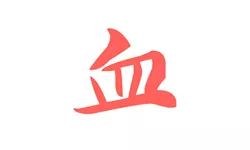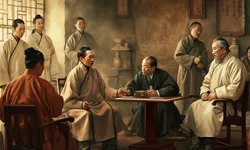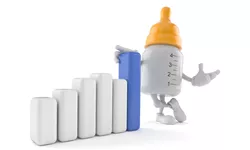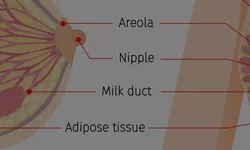Contents
- What are nipple vasospasms?
- Causes and treatment of nipple vasospasms
- Cause 1: Improper latching or suckling
- Cause 2: Sudden change of temperature on the nipple or the breast
- The nipple is exposed to cold temperature right after nursing
- Stepping out of a hot bath or shower
- Pumping in a room with cold temperature
- Drink a herbal tea to help you strengthen your immune system
- Cause 3: Nipple fissures or thrushes
- Cause 4: Emotional stress
- Cause 5: Substances to avoid
- What is Raynaud's phenomenon when it comes to breastfeeding?
- Managing pain associated with vasospasms and Raynaud's phenomenon
What are nipple vasospasms?
Nipple vasospasm refers to a sudden contraction of the nipples or the breasts' blood vessels so that the blood flow is reduced.

A normal vessel (top) versus vasospasm (bottom)
The typical symptoms are nipple blanching (i.e. the nipple becoming pale) and severe pain. The pain is often described as shooting, sharp or burning. There might also be a feeling of numbness in the nipple or the breast.
While this article focuses on vasospasms on the breasts or nipples, they can occur on any other parts of the body, such as the finger tips.
Causes and treatment of nipple vasospasms
Cause 1: Improper latching or suckling
Baby's suckling is too strong
Some babies suckle so strongly on the nipples that it even alters their shape (it becomes flattened or pointed).
This may cause vasospasms and/or blanching (i.e. the nipple becoming pale). The blanching often occurs immediately after pulling the nipple out of the baby's mouth. The pain typically comes after the blanching.
One common reason why your baby feels compelled to suckle so strongly is because your milk flow is insufficient due to some blockages.
If that's your case, you might want to consider drinking Unblock Nursing Tea. Its herbal ingredients can help remove the blockages and restore a normal milk flow.
Shallow latching
Shallow or improper latching might create vasospasms.
The baby's mouth has to cover the entire nipple and much of the areola, as shown in picture.

Proper baby latching
If your baby doesn't latch properly try a different nursing position. Your baby might have not latched properly simply because they were uncomfortable.
If you really can't figure latching out, consult your lactation consultant or pediatrician. In the meantime to avoid developing vasospasms try pumping and bottle feeding instead of direct nursing.
Cause 2: Sudden change of temperature on the nipple or the breast
The nipple is exposed to cold temperature right after nursing
This can happen if you nurse outdoor for instance.
This is easily avoidable by avoiding outdoor nursing or nursing in cold environment. And if you must do so, quickly cover your breasts and nipples with warm clothing straight after nursing.
Stepping out of a hot bath or shower
Again the easy solution is to avoid letting your breasts be exposed to strong temperature differences. So make sure to quickly dry and cover them after stepping out of the shower!
Pumping in a room with cold temperature
When you pump your breasts are more exposed to the environmental temperature than when you breastfeed. Always ensure to pump in a warm and comfortable environment.
Drink a herbal tea to help you strengthen your immune system
In order to develop vasospasms due to cold, your body needs to be sensitive to it in the first place. This can happen if you lack energy and your immune system is somewhat depressed. This is normal after birth-giving since you used so much energy and likely suffered massive blood loss.
To help you recover postpartum and strengthen your immune system, we recommend Milk Boost Tea.
It's inspired by traditional medicinal recipes used for more than 1,500 years by Chinese women to recover from birth-giving. It contain many postpartum recovery herbs such as Dong Quai, Cinnamon or Longan among others.

Milk Boost Tea is a herbal tea that can help you recover postpartum
Cause 3: Nipple fissures or thrushes
Nipple fissures or thrushes can lead to extreme pain and vasospasms can develop as a result of these pains. Healing those fissures or thrushes can therefore help prevent vasospasms.
To heal fissures or thrushes, we recommend the following steps:
- Apply nipple cream on the nipple fissures so as to reduce the pain during breastfeeding
- Use a nipple shield. It prevents the baby from suckling directly on the damaged nipple.
- Drink Unblock Nursing Tea. It is full of "cooling" herbs such as dandelions, honeysuckle flowers or chrysanthemum flowers. It will help reduce the risk of infections and inflammations.
- Avoid tight bras and clothing. It causes friction which may prevent healing. Instead wear light but warm coton breastfeeding bras that can allow your nipples to breathe.
- Do not overclean your nipples and breasts as some oil that is secreted by our own body acts as a natural healing cream.
Cause 4: Emotional stress
The relationship between emotional stress and vasospasms is well documented. This is because stress has a big impact on blood flow which in turn will put pressure on the blood vessels.
Dealing with emotional stress is, of course, easier said than done. It always helps to have as much support around you as possible to help you care for the baby. Sport also helps, such as yoga or soft running.
Milk Boost Tea might help too because of its capacity to help you recover from birth-giving. After giving birth, you typically suffer from fatigue and a big lack of energy, which are important contributing factors to stress. If you recover your energy, you'll deal with stress better and it won't affect you as much.
Cause 5: Substances to avoid
The following substances are believed to cause vasospasms or at least be aggravating factors:
- Pills for weight control
- Medicine against common cold that containing pseudoephedrine, phenylephrine or beta blockers
- Birth control pill containing estrogen
- Any drug that is vasoconstrictive
What is Raynaud's phenomenon when it comes to breastfeeding?
Raynaud's phenomenon is a severe case of vasospasms which is particularly painful. It typically happens to the fingertips but commonly affects nipples too.
Severe pain, often described as "throbbing", "shooting" or "burning" is not the only symptom. To be diagnosed with Raynaud's phenomenon the pain needs to be aggravated when the nipples are exposed to cold temperature.
Another characteristic of Raynaud's is that the nipple changes color when the patient suffers from a painful "Raynaud attack". The color change can be so-called "biphasic" when it changes from the normal red/pink to white (this is also called "nipple blanching"). It can also be "triphasic" when the skin color first changes to blue and then to white.
The causes and treatments of Raynaud's phenomenon
Raynaud's phenomenon being a severe case of vasospasms, the causes and treatments are the same as vasospasms.
As a result, please refer to the above 5 causes on vasospasms.
Managing pain associated with vasospasms and Raynaud's phenomenon
Here is what you can do to deal with the severe pain that's caused by vasospasms and Raynaud's:
- Try painkillers but please bear in mind that it only relieves the pain but doesn't cure the underlying cause:
- Try Unblock Nursing Tea if the issue is caused by bad latching (cause 1) or nipple fissures/thrushes (cause 3)
- Try Milk Boost Tea if the issue is caused by exposure to cold (cause 2) or emotional stress (cause 4)
Article tags: Breastfeeding and maternity








